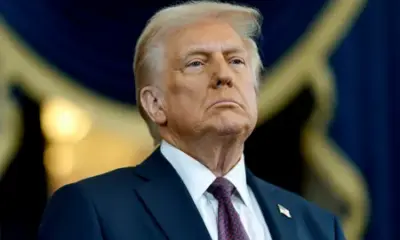World
US and EU Forge Trade Deal to Set 15% Tariff on Goods

The United States and the European Union have reached a significant agreement on trade, establishing a 15% tariff on most goods. This deal, confirmed on July 27, 2023, avoids the imminent threat of escalating tariffs that could have resulted in a trade war with far-reaching global economic consequences. The agreement was announced following a meeting between U.S. President Donald Trump and European Commission President Ursula von der Leyen at Trump’s Turnberry golf course in Scotland.
The negotiation, which culminated months of discussions, was prompted by a looming deadline for the Trump administration to impose tariffs on goods from the EU’s 27 member states. Trump described the outcome as “great for both parties,” stating, “It’s a good deal for everybody and a giant deal with lots of countries.” Von der Leyen echoed this sentiment, emphasizing that the deal would “bring stability” and “predictability” for businesses on both sides of the Atlantic.
Despite the optimism surrounding the agreement, several key details remain unresolved. Trump indicated that the EU had committed to purchase approximately USD 750 billion worth of U.S. energy over the next three years and to invest an additional USD 600 billion in the U.S. economy. He also mentioned that the tariff would apply “straight across” for various goods, including automobiles and other products.
During her remarks, Von der Leyen clarified that the 15% tariffs would cover the majority of EU exports, including cars, semiconductors, and pharmaceuticals. She highlighted that both sides had agreed to “zero for zero tariffs” on certain strategic goods, which include aircraft, semiconductor equipment, and specific agricultural products. The inclusion of alcohol in this category remains uncertain.
The next steps involve presenting the agreement to EU member states and lawmakers, who will ultimately decide on its adoption. Von der Leyen noted that the U.S. and EU together represent the world’s largest trade volume, comprising hundreds of millions of people and trillions of dollars in transactions. She acknowledged Trump’s reputation as a tough negotiator but stressed the importance of fairness in trade discussions.
Trump has previously indicated that he was prepared to implement tariffs as high as 30% if negotiations did not result in favorable conditions for the U.S. His administration has actively sought to reduce trade deficits with key partners, using the threat of tariffs as leverage. Following the announcement, U.S. Commerce Secretary Howard Lutnick confirmed that the deadline for imposing tariffs was firmly set for August 1, 2023, with no extensions.
Without a trade agreement, the EU had been preparing to retaliate with tariffs on a variety of American goods, a move that could have increased prices for consumers in the U.S. across numerous sectors, including food and technology. Reflecting on the deal, Trump stated, “I think it’s great that we made a deal today, instead of playing games and maybe not making a deal at all.”
As the U.S. and EU move forward, the focus will be on finalizing the agreement’s details and ensuring that both sides benefit from the negotiated terms. The implications of this deal could have a significant impact on international trade relations and economic stability moving forward.
-

 World2 weeks ago
World2 weeks agoTorrential Rains Cause Flash Flooding in New York and New Jersey
-

 Top Stories2 weeks ago
Top Stories2 weeks agoKonkani Cultural Organisation to Host Pearl Jubilee in Abu Dhabi
-

 Science2 weeks ago
Science2 weeks agoNothing Headphone 1 Review: A Bold Contender in Audio Design
-

 Top Stories2 weeks ago
Top Stories2 weeks agoAir India Crash Investigation Highlights Boeing Fuel Switch Concerns
-

 Business2 weeks ago
Business2 weeks agoIndian Stock Market Rebounds: Sensex and Nifty Rise After Four-Day Decline
-

 Lifestyle2 weeks ago
Lifestyle2 weeks agoCept Unveils ₹3.1 Crore Urban Mobility Plan for Sustainable Growth
-

 Politics2 weeks ago
Politics2 weeks agoAbandoned Doberman Finds New Home After Journey to Prague
-

 Top Stories2 weeks ago
Top Stories2 weeks agoPatna Bank Manager Abhishek Varun Found Dead in Well
-

 World2 weeks ago
World2 weeks agoSBI Announces QIP Floor Price at ₹811.05 Per Share
-

 Science2 weeks ago
Science2 weeks agoTesla’s Model Y and Model 3 Lead U.S. EV Sales Despite Decline
-

 World2 weeks ago
World2 weeks agoTrump Expresses Disappointment in Putin, Affirms NATO and UK Ties
-

 Sports1 week ago
Sports1 week agoArshdeep Singh Suffers Hand Injury Ahead of Key Manchester Test









